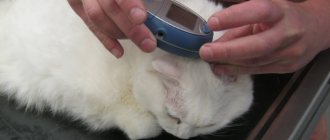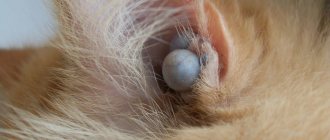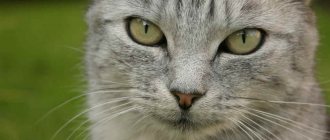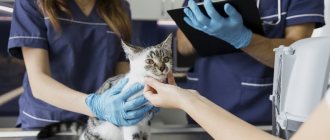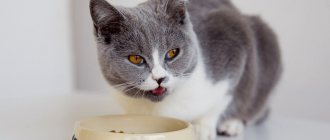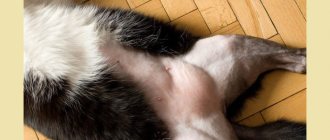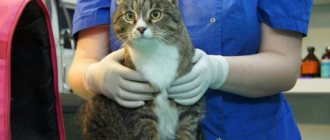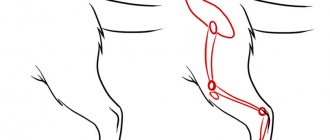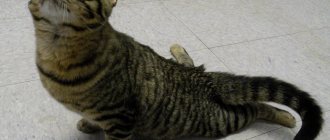5727Pavel
4
Often, owners do not pay attention to the temperature of their pet’s paws. Does your cat have cold paws? But this can be an important sign of the animal’s distress, especially if this symptom manifests itself for quite a long time.
Of course, you shouldn’t worry about why your cat has cold paws and assume the worst. If the tips of your cat's paws are constantly getting cold, you should first understand the cause of this condition. This will help prevent negative consequences in the future.
© shutterstock
At a doctor’s appointment, the cat’s owner will most likely remember when, what and how his beloved cat ate, when and how much water he drank, but at what time his paws began to become cold is unlikely. The veterinarian should be provided with detailed information, which is why it is necessary to monitor your pet carefully.
You need to know that in cats, body temperature changes quite seriously over 24 hours. The amplitude can be more than one degree. Therefore, it is difficult to track exactly when a cat’s paw pads became colder than usual. Nevertheless, it is worth trying, diagnosis and help depend on it.
What is the normal state of the animal?
Domestic cats and dogs living in city apartments have very sensitive paws throughout their lives. Cats that are used to walking a lot in the open air, and even more so those living in the yard or even homeless animals, have paws that are little susceptible to both cold and heat. As the pads of their limbs hardened, the nerve endings became more resilient. Therefore, the temperature of the paws of cats living outside and at home is slightly different to the touch.
However, the normal temperature of the paws is cooler than the body. However, they must be warmer than the environment, even if the cat walks in the snow.
While sleeping, your cat's paws become hotter. Because in a state of complete rest, when the animal lies down and all the muscles relax, the immune system works powerfully. And this, in turn, affects the overall body temperature of the animal, increasing it. Cats sleep 18 hours a day. Sleep gives way to drowsiness - this is a state when the mind is active and the body is relaxed. At this moment, the paws become a little cooler.
Signs of hypothermia
There are a number of main signs of hypothermia in cats that are easy to notice:
- trembling – when a cat is cold, it begins to tremble. This is a natural way to generate heat, writes DailyPaws;
- cold paws, tail, nose and ears. Without normal blood flow, their risk of frostbite also increases;
- pale or gray gums.
When a cat is trying to conserve body heat, it may stop looking for a source of heat and curl up in a ball. At this stage, the animal may experience mild hypothermia. As it becomes more severe, your heart rate and breathing slow down. A cat suffering from severe hypothermia may lose consciousness and go into a coma.
What factors cause a cat's paw temperature to drop?
The thermoregulation function is vital for all living organisms, including cats. Healthy, full-fledged animals do not need to carefully monitor the temperature of their paws. But older individuals and kittens need observation. Because their thermoregulation is weakened due to age and condition of the body. Therefore they need special care.
© shutterstock
The speed of metabolic reactions in the body is the basis of thermoregulation. Moreover, if the carbohydrates that a cat absorbs with food are broken down quickly, then its body will have a higher temperature.
However, there is an exception to this natural rule:
- In older cats, the rate of carbohydrate metabolism is reduced.
- Small kittens have a high metabolism, but it involves a small amount of carbohydrates. It is simply different in its chemical composition.
- You need to pay attention to hairless breed cats. After all, they do not have the ability to sufficiently control heat exchange with the environment, since there is no wool. Therefore, even in a warm house, this cat should be dressed in overalls.
If the cat is in a cool room, then, naturally, the temperature of the paws should be colder than usual. Especially if the animal starts to doze.
However, when it gets too hot, the paw pads also become cool. The fact is that cats have special glands, similar to sweat, deep between their toes, which can, if necessary, release moisture. This mechanism allows you to compensate for increased body temperature during extreme heat. Because moisture evaporates, cooling the skin. Long-haired and short-haired cats “sweat” equally. However, this phenomenon is more noticeable in individuals with short hair.
Types of colors
The main types of coat color of the Abyssinian cat:
- classic wild;
- blue;
- sorrel;
- faun.
In addition to the four main colors included in the breed standard, there are other types of colors of Abyssinian cats:
- lilac;
- brown;
- tortoiseshell;
- black.
Black Abyssinian cats are spectacular and elegant. Despite the fact that this color is not included in the standard, they are popular.
In fact, the fur of these cats is dark chocolate or black-gray. The belly is lighter - gray or brown.
It is difficult for breeders to achieve the consolidation of black color in the color, because there are very few Abyssinians with black ticking.
Classic wild color
At first, this color was the only color standard for the Abyssinian cat breed. Today this is the most common and popular shade. It contains rich ocher, brown, and black tones.
Compliance with standards is determined by the following parameters:
- ticking must be uniform, at least 3 segments;
- the sides and back are painted a darker ocher-brown color than the lower part of the body;
- the paws have black fringes;
- a black stripe runs along the entire length of the ridge;
- the nose is terracotta-colored, clearly defined;
- eyes the color of gold, walnut, emerald.
Different degrees of shade intensity are allowed
It is important that no extraneous colors are mixed into the base ones.
Sorrel
Sorrel translated from English means “bay, red.” This color is warmer than the classic one; it is dominated by red shades of wool, the color of copper, apricot, and chocolate.
Characteristics:
- the main ticking background can be of two types: dark chocolate or cinnamon color;
- The presence of black hairs in the wool is unacceptable;
- the tummy and paws are colored apricot on the inside;
- dark stripe on the spine and tail;
- the pale pink nose is outlined in red;
- paw pads pink-beige;
- eyes are the color of gold and copper, greenish or dark hazel shades are acceptable.
Blue
This type of color was approved relatively recently. The name of the suit was given by a delicate smoky blue tint. The combination of pearl, beige and slate gray shades in the ticking segments gives an unusual effect.
Standard requirements for an Abyssinian blue cat:
- on the frontal part of the muzzle there is a pattern similar to the tails of a tailcoat;
- on the lower part of the body from the chin to the tummy, the color of the coat is light beige and apricot tones;
- along the ridge there is a narrow stripe of a tone more saturated than the main color with a pronounced bluish tint;
- the nose is blue-gray or terracotta in color with a clear dark outline;
- paw pads pale pink;
- the undercoat should be lighter than the base color, but not whitish;
- eyes are golden, copper in color, less often green or hazel.
Faun
Translated from English, faun means fawn. This is the rarest shade of the Abyssinian cat. The color is similar to sorrel, but less intense.
The exquisitely colored Abyssinian fawn cat is incredibly elegant. Thanks to her plasticity, she looks like a lioness and is graceful like a deer.
Color characteristics:
- ticking with segments of coffee, cream, beige, chocolate with milk color;
- along the spine to the tip of the tail there is a stripe of a rich pink-beige hue;
- the undercoat is lighter and brighter than the main color;
- the pink nose is outlined with a reddish outline;
- the belly and paws are covered with gray-beige fur;
- Eye color must comply with breed standards.
The owners of Abyssinians are firmly convinced that the character and temperament of a cat depends on its color:
- wild ones are proud, independent and extremely intelligent;
- sorrel - cheerful and perky;
- fauns and blues are gentle and sensitive.
Should you measure your cat's body temperature?
Cold hind legs, ears and nose - this condition indicates that the animal’s overall body temperature has decreased.
© shutterstock
If you feel that not only the paws, but the entire body of the animal has become noticeably colder than usual, be sure to measure the temperature. If the reading is below normal - 38 degrees, you should immediately contact your veterinarian.
In this case, you cannot waste time, because there can be many reasons for an abnormal decrease in a cat’s body temperature. Only a doctor can establish an accurate diagnosis and help your pet. Letting the situation take its course or self-medicating is unacceptable.
Diagnosis of paw paralysis
If the initial examination is not enough to determine the cause of paw paralysis, then the following diagnostic methods are used:
- determination of neurological reactions;
- X-ray of the spine and affected limbs;
- Ultrasound of the abdominal cavity;
- detailed blood and urine analysis;
- taking smears for bacteriological analysis;
- MRI and CT scans of areas of the body where pathology is suspected to exist (spine, abdominal cavity, brain);
- determining the level of sensitivity of the affected limbs.
Features of thermoregulation of hairless breeds
A special group consists of hairless cat breeds that require assistance from the owner to regulate heat production. According to observations:
- Temperatures below +26°C are cool for hairless cats, and therefore they need to be dressed in comfortable clothes that cover a significant part of the body (chest, tummy and paws). Owners of hairless cats acquire a whole wardrobe for their pets, depending on the weather, wearing either a warm woolen sweater or a comfortable bodysuit made of linen knitwear.
- An indicator of a pet’s well-being is its behavior: a freezing cat will constantly shrink into a ball, meow pitifully, hide under the blanket or jump into the owner’s arms. Hypothermia is indicated not only by the pet’s cool paws and nose, but also by the entire surface of the skin.
- In winter, it is recommended to arrange a “heated bed” for sphinxes by hanging a special hammock with a reliable frame on the central heating radiator. This will allow the animal to sleep in warmth and comfort, while simultaneously occupying an advantageous “hunting” position.
- Hairless cats should never be allowed to lie on the floor in drafts or sit near an open window. Rapid hypothermia of a naked body is fraught with a decline in immunity and serious illnesses.
The cat has a dry and warm nose: what to do at home?
If your cat feels fine and nothing serious has happened to him, you can help your pet yourself. We offer you special measures that will be useful to you if your cat has a dry and warm nose.
- The cat's nose is dry and dirty. If you don’t clean your cat’s nose, it can become dirty, after which it will be difficult for the pet to breathe and the physiological lubrication of the nose will decrease. As a result, thermoregulation will be disrupted and the nose will be hot.
- Carefully clean the dirty spout from the outside and inside. Be careful not to damage sensitive tissue. After approximately 20 min. you will notice that your cat's condition returns to normal.
- Burn from strong sun rays. Every cat loves to sleep in the sun. But prolonged sleep under strong rays of the sun does not bring any benefit. Situations with burns are much more common than expected. This is especially true for those individuals who have a delicate pink nose.
- In a cat that has received a sunburn, the nose becomes red, hot, and the pet feels pain at the slightest touch. Over time, the skin on the nose becomes rougher, it becomes dry and rough. In this case, treat the cat’s nose with an anti-burn drug that has moisturizing and anti-inflammatory properties. Apply the product carefully so that it does not penetrate the nostrils. Repeat the procedure again until the nose looks normal.
Treat your nose
- Allergic reaction to chemicals. Many pets can have allergies. Don't forget about this when cleaning the house. If you do not wash the product well, it can cause great harm to the cat, who likes to poke his own nose into every corner.
- Urgently carry out another wet cleaning. Wash all surfaces thoroughly with clean water. Wash away any remaining chemicals that may cause irritation or allergies in your cat. Also does not include consultation with a veterinarian. He will tell you which antihistamine can be given to your pet and in what dose.
